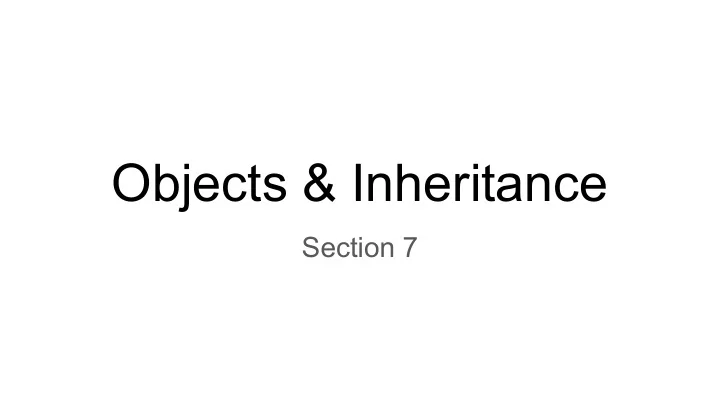

Objects & Inheritance Section 7
Implementing Objects in 401 Ways of implementing objects: ● Use closures as objects ● Use tables as objects
Closures as Objects Datatype name Datatype fields function myObject (field1, field2, field3 ...) { function (methodName, param1, param2) { if (methodName == "method1“) { Datatype methods /* method1 code */ } else if (methodName == "method2“) { /* method1 code */ } else { error("invalid action") } } } def x = myObject(0,1,2) // Create instance of data type called x x(“method1”, 10, “asd”) // Call method1 on object x
Tables as Objects Datatype name Datatype fields def myObject = {field1 = x, field2 = y, field3 = z, ...} myObject[“method1”] = function(self, param1, param2, ...) { /* method1 code */ } Datatype methods myObject[“method2”] = function(self, param1, param2, ...) { /* method2 code */ } // Create instance of data type called x and call method 1 def x = { field1 = 5, method1 = myObject[“method1”], method2 = myObject[“method2”] } x[“method1”](x,a,b,c); We can use de-sugaring to improve syntax. For example: x:method1(a,b,c) becomes x[“method1”](x,a,b,c)
Exercise 1 a) Use closures to build a custom datatype Square . The data structure should have one attribute length and two methods getArea and setLength . b) Use tables to define the same Square datatype. For this exercise, assume no de-sugaring.
Prototypes - Prototypes are just like regular objects - Contain shared methods and attributes - All objects of the a datatype extend the prototype of that datatype - Similar to lexical scoping, objects have a pointer to their prototype - When we cannot find a field or method in the object, we search the prototype - We keep the prototype pointer in the special __index field.
Square example /* Create the prototype object */ def Square = {length = 5} Square[“getArea”] = function(self) { length * length } Square[“setLength”] = function(self, newLength) { self.length = newLength } Square[“new”] = function(self) { def o = {} o.__index = self o } /* Create instance of datatype */ def x = Square[“new”](Square) or with desugaring it simply becomes: def x = Square:new()
How __index is used. ⇒ def x = Square:new() __index __index null length 5 getArea ... setLength ... new ... ⇒ x.length = x.length + 10 __index __index null length 15 length 5 getArea ... setLength ... new ...
Exercise 2 Using tables and prototypes, define the following datatypes and create one instance of each type. You may assume desugaring. Name: Shapes No attributes Methods: new Name: Square Name: Circle Attributes: length Attributes: radius Methods: setLength, getArea Methods: setRadius Name: Rectangle Attributes: width Methods: setWidth, getArea
Fin.
Recommend
More recommend